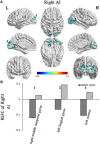Abnormal Resting-State Functional Connectivity of Insular Subregions and Disrupted Correlation with Working Memory in Adults with Attention Deficit/Hyperactivity Disorder
- PMID: 29075206
- PMCID: PMC5641567
- DOI: 10.3389/fpsyt.2017.00200
Abnormal Resting-State Functional Connectivity of Insular Subregions and Disrupted Correlation with Working Memory in Adults with Attention Deficit/Hyperactivity Disorder
Abstract
Objectives: Executive function (EF) deficits are major impairments in adults with attention deficit/hyperactivity disorder (ADHD). Previous studies have shown that the insula is involved in cognitive and EFs. However, the insula is highly heterogeneous in function, and few studies have focused on functional networks which related to specific insular subregions in adults with ADHD. We explored the functional networks of the insular subregions [anterior insula (AI), mid-insula (MI), and posterior insula (PI)]. Furthermore, their correlations with self-ratings of ecological EFs, including inhibition, shifting, and working memory were investigated.
Methods: Resting-state functional magnetic resonance imaging data in 28 adults with ADHD and 30 matched healthy controls (HCs) were analyzed. The seed-based resting-state functional connectivity (RSFC) of the insular subregions was evaluated. We also investigated their associations with the Behavior Rating Inventory of Executive Function-Adult Version (BRIEF-A) inhibition, working memory, and shifting factor scores.
Results: Compared with HCs, adults with ADHD showed altered RSFC of the AI, with the precuneus, precentral gyrus, and inferior temporal gyrus extended to the middle temporal gyrus, lingual gyrus, and superior occipital gyrus, respectively. There were no significant differences in RSFC of the MI and PI between the two groups. Within the HC group, working memory scores were associated with the RSFC of AI with precuneus and temporal gyrus. However, there was no correlation between these variables in the ADHD group.
Conclusion: The study evaluated RSFC patterns of the insular subregions in adults with ADHD for the first time. Altered RSFC of the AI which is a crucial region of salience network (SN) and part of regions in default mode network (DMN), were detected in adults with ADHD in both results with and without global signal regression (GSR), suggesting that disrupted SN-DMN functional connectivity may be involved in EF impairments in adults with ADHD, especially with respect to working memory. Deficits of the AI which is involved in salient stimuli allocation, might be associated with the pathophysiology of ADHD. The inconsistent results of MI and PI between analyses with and without GSR need further exploration.
Keywords: attention deficit/hyperactivity disorder; default mode network; executive function; insular subregions; resting-state functional connectivity; salience network.
Figures



Similar articles
-
Altered Functional Connectivity of Insular Subregions in Alzheimer's Disease.Front Aging Neurosci. 2018 Apr 11;10:107. doi: 10.3389/fnagi.2018.00107. eCollection 2018. Front Aging Neurosci. 2018. PMID: 29695961 Free PMC article.
-
Altered resting-state functional connectivity of insula in children with primary nocturnal enuresis.Front Neurosci. 2022 Jul 19;16:913489. doi: 10.3389/fnins.2022.913489. eCollection 2022. Front Neurosci. 2022. PMID: 35928018 Free PMC article.
-
Altered functional connectivity of insular subregions in subjective cognitive decline.Front Hum Neurosci. 2024 May 27;18:1404759. doi: 10.3389/fnhum.2024.1404759. eCollection 2024. Front Hum Neurosci. 2024. PMID: 38859994 Free PMC article.
-
Impairments of large-scale functional networks in attention-deficit/hyperactivity disorder: a meta-analysis of resting-state functional connectivity.Psychol Med. 2019 Nov;49(15):2475-2485. doi: 10.1017/S003329171900237X. Epub 2019 Sep 10. Psychol Med. 2019. PMID: 31500674 Review.
-
Different functional alteration in attention-deficit/hyperactivity disorder across developmental age groups: A meta-analysis and an independent validation of resting-state functional connectivity studies.CNS Neurosci Ther. 2023 Jan;29(1):60-69. doi: 10.1111/cns.14032. Epub 2022 Dec 5. CNS Neurosci Ther. 2023. PMID: 36468409 Free PMC article. Review.
Cited by
-
The neural basis of executive functioning deficits in adolescents with epilepsy: a resting-state fMRI connectivity study of working memory.Brain Imaging Behav. 2021 Feb;15(1):166-176. doi: 10.1007/s11682-019-00243-z. Brain Imaging Behav. 2021. PMID: 32043232
-
Autism-associated brain differences can be observed in utero using MRI.Cereb Cortex. 2024 Apr 1;34(4):bhae117. doi: 10.1093/cercor/bhae117. Cereb Cortex. 2024. PMID: 38602735 Free PMC article.
-
The association between fronto-insular interaction and executive function during childhood and adolescence in a resting state fMRI study.Sci Rep. 2025 Aug 17;15(1):30096. doi: 10.1038/s41598-025-14736-z. Sci Rep. 2025. PMID: 40820084 Free PMC article.
-
Functional connectivity of the pediatric brain.Neuroradiology. 2024 Nov;66(11):2071-2082. doi: 10.1007/s00234-024-03453-5. Epub 2024 Sep 4. Neuroradiology. 2024. PMID: 39230715 Review.
-
Altered brain functional connectivity in patients with resistance to thyroid hormone ß.PLoS One. 2024 Aug 22;19(8):e0306538. doi: 10.1371/journal.pone.0306538. eCollection 2024. PLoS One. 2024. PMID: 39172991 Free PMC article.
References
-
- American Psychiatric Association. Diagnostic and Statistical Manual of Mental Disorders: Text Revision. 4th ed Washington, DC: American Psychiatric Association; (2000).
LinkOut - more resources
Full Text Sources
Other Literature Sources
Research Materials
Miscellaneous

